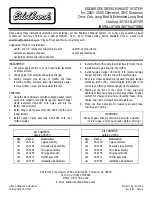
The route presents limits (some
roads are too steep and bumpy for
example). You have limits (in driving
skills and comfort). And your vehicle
also has limits (traction, stability, and
power, for instance).
Driving off-highway can be
hazardous if you fail to recognize
limits and take proper precautions.
For example, you can have an
accident or rollover during
maneuvers such as turning, driving
on hills, or over large obstacles.
Utility vehicles have a significantly
higher rollover rate than other types
of vehicles. To avoid loss of control
or rollover, be sure to follow all
recommendations and precautions
on page
and in this section.
Seat belts are just as important off-
road as on paved roads. Wherever
you drive, make sure you and your
passengers always wear seat belts. If
children or infants are along for the
ride, see that they are properly
secured. In a rollover crash, an
unbelted person is more likely to die
than a person wearing a seat belt.
On many unpaved roads, you won’t
find lane markers, traffic signals, or
signs to warn you of possible trouble
ahead. It’s up to you to continually
assess the situation and drive within
limits.
Remember that your MDX has
higher ground clearance and a
higher center of gravity than
passenger vehicles designed for use
only on pavement. This means your
vehicle can more easily tip or roll
over if you make abrupt turns or
drive on slopes.
Be sure to store cargo properly, and
do not exceed your MDX’s cargo
load limits (see pages
and
).
250
246
271
Important Saf ety Precautions
Off-Highway Guidelines
Driving
286
Improperly operating this
vehicle on or off-pavement can
cause an accident or rollover in
which you and your passengers
could be seriously injured or
killed.
Follow all instructions and
guidelines in the owner’s
manual.
Keep your speed low and
don’t drive faster than
conditions permit.
02/07/30 22:07:58 31S3V620 0291
















































